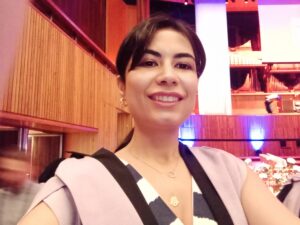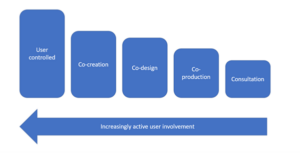“This week’s blog post is written by Betul BAY, a PhD candidate with expertise in cancer pain management among children and young people at the University of Birmingham’s School of Nursing and Midwifery. Within this blog, she underscores the importance of further research aimed at establishing the most optimal levels of Patient and Public Involvement and Engagement (PPIE) to enhance the empowerment of children and young people (CYP).” @HOPPS_UOB
How well do we adult researchers really prepare ourselves to share power and control with children and young people in the context of patient and public involvement?
When speaking of children’s rights, this should extend beyond the right to protection. They also have the right to shape the society in which they live as moral agents with their visions of the world, intentions, and meanings. In 1959, the movement for children’s civil, social, cultural, economic, and political rights gained momentum with the Declaration of the Rights of the Child (UNCRC), the United Nation General Assembly (United Nation General Assembly, 1959). However, the biological differences of children from adults still stand as an obstacle to giving due consideration to the things children value to lead a good life and accepting children’s capabilities and functions as guiding principles to their well-being.
Children can best describe what it is like to be a child because they are an expert in their own childhood experiences. If you spend time around children, you observe that they act as individuals, developing meanings out of their experiences and interactions, as well as creating meanings for their own lives. We need to develop a better trust in children’s ability to talk not only about their own childhood, but also about their lives within their family and in the wider community. As adults, how willing we are to listen to children determines the extent to which we can legitimize and empower them and learn more from them (Uprichard, 2010). So, how can we meaningfully hear the voices of children and young people (CYP) in the context of research focusing on their health and well-being?
In conducting my own research, which aims to inform the design of a digital resource to improve the pain experience of CYP with cancer pain and their parents at home, I relied upon the article 12 of UNCRC. Article 12 discusses the concept of “participation,” emphasizing the active involvement of CYP in decisions that affect their own lives, as well as broadening the concepts of “provision” and “protection” (United Nation General Assembly, 1989):
“The child who is capable of forming his/her own views the right to express those views freely in all matters affecting the child, the views of the child being given due weight in accordance with the age and maturity of the child”.
As I began to explore the ethical issues that could arise during my research, I began to think about how CYP could be more involved in my research, not only as participants, but also with the design, development, and implementation. As an international student, I had never heard about “patient and public involvement and engagement” (PPIE) until starting my PhD. On the advice of my supervisors, I started to explore PPIE. INVOLVE (2012, p.6) defines PPIE as:
“Research being carried out ‘with’ or ‘by’ members of the public rather than ‘to’, ‘about’ or ‘for’ them”.
In my first literature review, I noticed a lack of understanding and consensus internationally regarding PPIE terminology and approaches to incorporating the public in research, but also that much of the published literature focuses on adult’s experiences of PPIE. There is limited understanding of how PPIE works for CYP and/or families. The literature to date has also mainly centred on CYP’s competence (sometimes used interchangeably with capacity) to participate. The evidence on the approaches used by researchers to involve CYP and/or families in research and how their views affect decision-making remains limited (Rouncefield-Swales et al., 2021).
The underlying philosophy of PPIE with CYP seeks to ensure their human dignity is respected, and that their rights and well-being are respected. The literature on CYP involvement considers:
- Tokenism (symbolic forms of involvement)
- CYP’s possibilities for action remain limited within a space predefined by adults.
- Meaningful involvement should be initiated by CYP – identifying concerns they want to explore and choosing the way they want to be involved.
(Rouncefield-Swales et al., 2021).
It took me a while to realize that when involving CYP, researchers need to ask themselves what level of involvement CYP could have in the study. This is crucial to ensure meaningful involvement, respect for CYP’s rights, and the creation of inclusive and safe spaces for their involvement. The a hierarchy of active involvement is outlined in Figure 1.
Figure 1: Hierarchy of Active Involvement
The involvement of CYP in research results in practical and ethical challenges even 50 years after the adoption of the UNCRC. Concerns are largely practical in terms of the difficulties faced by CYP within activities and with their involvement. Challenges range from symbolic and lack of CYP influence on decision-making, to the lack of sustainability of involvement activities. However, the primary concern about CYP involvement is what the effects of the different levels and roles of CYP is on the actual research and on the CYP (Preston et al., 2023). This ambiguity about involving CYP and/or parents requires future research to answer questions not only about which level of PPIE would contribute more to research but also to empower CYP’s capacity.
References
United Nations General Assembly (1989). Convention on the Rights of the Child. Available: https://www.ohchr.org/en/instruments-mechanisms/instruments/convention-rights-child [Accessed 23 August 2023]
INVOLVE (2012). Briefing notes for researchers – public involvement in NHS, health and social care research. INVOLVE, Eastleigh. Available: https://www.invo.org.uk/wp-content/uploads/2014/11/9938_INVOLVE_Briefing_Notes_WEB.pdf [Accessed 23 August 2023].
National Institute for Health and Care Research (2021). Briefing notes for researchers. Available: https://www.nihr.ac.uk/documents/briefing-notes-for-researchers-public-involvement-in-nhs-health-and-social-care-research/27371#briefing-note-seven-approaches-to-public-involvement-in-research [Accessed 23 August 2023].
Preston, J., Biglino, G., Harbottle, V. et al. (2023). Reporting involvement activities with children and young people in paediatric research: a framework analysis, Res Involv Engagem, 9(61).
Rouncefield-Swales, A., Harris, J., Carter, B. et al. (2021) ‘Children and young people’s contributions to public involvement and engagement activities in health-related research: A scoping review’, PloS one, 16(6), p. e0252774.
Uprichard, E. (2010). Questioning research with children: Discrepancy between theory and practice?. Children & Society, 24(1), 3-13.

